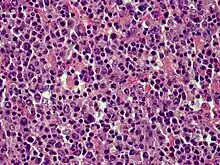Cutaneous B-cell lymphoma
Cutaneous B-cell lymphomas constitute a group of diseases that occur less commonly than cutaneous T-cell lymphoma, and are characterized histologically by B-cells that appear similar to those normally found in germinal centers of lymph nodes.[1]: 741 Conditions included in this group are:[1]: 740–743
| Cutaneous B-cell lymphoma | |
|---|---|
 | |
| Cutaneous diffuse large B-cell lymphoma | |
| Specialty | Dermatology/Oncology |
Signs and symptoms
Cutaneous B-cell lymphoma appears as single or many, often strongly consistent tumors, patches, plaques, and non-ulcerated nodules. While extracutaneous spread is a possibility, the disease usually stays restricted to the skin.[2]
Diagnosis
Using a biopsy of the skin lesions, histological and cytological analyses, as well as phenotypic and genotypic studies, the diagnosis is made.[2]
References
- James, William D.; Berger, Timothy G.; et al. (2006). Andrews' Diseases of the Skin: clinical Dermatology. Saunders Elsevier. ISBN 0-7216-2921-0.
- Lima, Margarida (2015). "Cutaneous primary B-cell lymphomas: from diagnosis to treatment". Anais Brasileiros de Dermatologia. 90 (5). FapUNIFESP (SciELO): 687–706. doi:10.1590/abd1806-4841.20153638. hdl:10400.16/1960. ISSN 0365-0596.
Further reading
- Vitiello, Paola; Sica, Antonello; Ronchi, Andrea; Caccavale, Stefano; Franco, Renato; Argenziano, Giuseppe (2020-05-27). "Primary Cutaneous B-Cell Lymphomas: An Update". Frontiers in Oncology. 10. Frontiers Media SA. doi:10.3389/fonc.2020.00651. ISSN 2234-943X. PMC 7266949.
- Gurumurthy, Ravichandran; Mohapatra, RanjanKumar; Easow, JoseM; Mohan, Subhashini (2015). "Cutaneous B cell lymphomas: Report of two interesting cases". Indian Journal of Dermatology. 60 (2). Medknow: 176. doi:10.4103/0019-5154.152521. ISSN 0019-5154. PMC 4372911.
External links
This article is issued from Wikipedia. The text is licensed under Creative Commons - Attribution - Sharealike. Additional terms may apply for the media files.